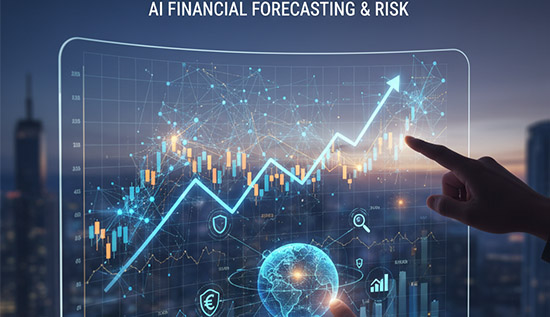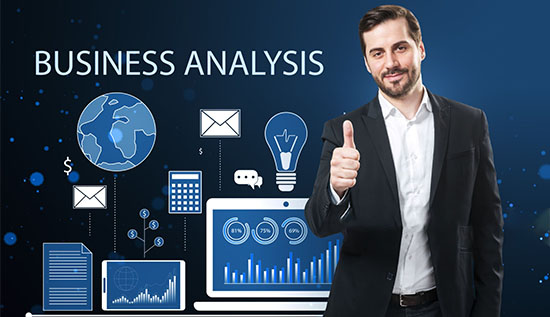Predictive AI in Finance | AI Financial Forecasting & Risk

Predictive AI in finance transforms forecasting and investment strategies with advanced machine learning and real-time financial analytics.
The finance industry depends on being able to guess what will happen with stocks, evaluate loan failures, control volatility and get ready for risks that come up out of the blue also.
But the old ways of making predictions, like spreadsheets, hand trend analysis and static models, don't always work well with how complicated markets are now. This is where predictive AI in finance comes in, ushering in a new era of precision, automation and adaptability.
By merging machine learning finance applications with large-scale data analytics, financial institutions can uncover hidden patterns and trends that human analysts might overlook.
From ai financial forecasting that improves revenue predictions to ai-powered financial models, using predictive AI for transforming raw data into insights that can be effectively implemented, investments are optimized.
In this comprehensive guide, we’ll explore how predictive AI in finance reshapes modern banking and investment strategies also. There are going to be detailed examples, step-by-step instructions on how to make AI models and actual-world use cases which demonstrate how prominent banking institutions, emerging fintech companies and financial services companies use AI to make better decisions and mitigate danger.
Understanding Predictive AI in Finance
At its core, predictive AI in finance applies advanced data-driven algorithms, deep learning networks and intelligent pattern recognition to anticipate future financial outcomes with remarkable accuracy. Normal regression or econometric models use set formulas and small amounts of old data. ]
AI-driven prediction systems, on the other hand, learn on the fly from huge amounts of data that are constantly being updated. They can use new information right away, which makes them much better at responding to quick changes in the market, in politics or in how people act.
AI models can look at both structured and unstructured data in the financial world. Structured data includes transaction histories, stock prices, interest rates and balance sheets. Unstructured data includes things like social media sentiment, news feeds, analyst comments and even satellite imagery.
This hybrid capability allows predictive analytics in banking and investment to generate a much deeper more nuanced view of the market landscape than traditional tools ever could.
For example, think about a big asset management company that has to guess how the market will respond to sudden changes in policy. A typical model might look at a few macroeconomic factors and how prices have changed in the past.
By contrast, predictive AI in finance can ingest and cross-reference thousands of variables simultaneously from breaking news headlines and what people on Twitter think about packages of goods and how people use their credit cards. The output is not just a fixed guess, but a living system that is always learning and can change its predictions every minute.
In practice, predictive analytics in banking combines techniques such as:
- Natural Language Processing (NLP): To interpret financial reports, analyst notes or real-time news and assign sentiment scores.
- Computer Vision: The number of cars in parking places or ships in ports that can be seen from space in order to figure out what people are doing or how trade is flowing.
- Time-Series Forecasting Models: LSTM networks and transformer-based architectures are two types of networks that can be used to dynamically predict prices, interest rates and risk measures.
When machine learning is combined with different types of data streams, it makes the forecasting engine much fuller and more aware of its surroundings.
Example 1: A hedge fund specializing in retail stocks employs predictive AI for stock market forecasting to interpret alternative data. It processes satellite imagery to measure parking lot occupancy outside shopping malls, social media sentiment around product launches and online search trends.
All of these pieces of information show whether people are spending more or less before the official sales numbers come out. The AI model tells traders days before competitors who use traditional data sources to invest in areas that are doing well.
Ultimately, predictive AI in finance is not merely about automation it’s about augmentation. It enhances human judgment, adds adaptable intelligence to all financial decisions and increases the depth of analysis.
Predictive AI is the next step in financial predictions from looking backwards to seeing the future. It can find new market trends before they happen and stop huge losses before they happen.
The Core Advantages of Predictive AI in Finance
The rise of predictive AI in finance marks a major shift in how institutions forecast, plan and manage risks. Financial companies used to rely on paper reports and old-fashioned models, but now they use AI-powered models that process huge amounts of data in real time.
This shift helps banks, insurers and investment firms act proactively instead of reactively turning raw data into valuable foresight.
With fintech AI solutions and machine learning finance applications, institutions gain faster insights, better forecasting precision and stronger risk control. Predictive AI in finance is an important tool for today's financial environment because of these main benefits.
- Improved Financial Forecasting Accuracy: Traditional forecasting models rely on limited historical data. AI financial forecasting combines time-series models with outside factors like inflation rates, to get around this problem, look at how customers feel and how loan rates are moving. This is because neural networks can figure out complex relationships that don't follow a straight line. In turn, this helps them make predictions that are more correct and flexible.
- Proactive Risk Management: With ai risk management, it is possible for banks and lenders to see potential failures, liquidity risks and market downturns coming before they happen. AI systems that can predict the future can pick up on early warning signs like strange payment patterns, sudden changes in the links between assets or spikes in market volatility. Example: A global bank’s ai-powered financial risk management solutions scan client portfolios daily, identifying high-risk assets and recommending immediate rebalancing to reduce exposure.
- Fraud Detection and Compliance: Fraudulent activities and money laundering cost financial institutions billions annually. AI is used in predictive analytics for banks to find strange things by looking at millions of deals all the time. In this way, rules are followed and customer trust is kept safe also.
- Personalized Financial Services: By leveraging machine learning finance applications, Banks and fintechs can look at how people spend their money and make personalized suggestions, that will make customers pleased and keep them as customers, like loan offers and commercial goods.
Step-by-Step Guide: Building a Predictive AI Framework for Finance
Let’s walk through a complete process to develop a predictive AI in finance system from accumulating data to putting the information to application.
Step 1: Define the Financial Objective
Clearly state what you want to guess like bad credit, loan payments that are late, market returns, customers leaving or the chance of scams.
Every financial AI solution starts with a clear goal that is in line with business KPIs that can be measured.
Step 2: Gather & Clean Financial Data
Collect information from a lot of different places, such as transaction logs, price data, credit histories, economic considerations and even search trends have all been previously documented.
- Data cleaning removes errors or outliers.
- Normalization ensures data is consistent for machine learning.
- Labeling defines what you want the model to predict (e.g., “default” vs. “non-default”).
Step 3: Engineer Features
Feature engineering is crucial for ai-powered financial models. Examples of features include:
Trends in credit utilization ratios, moving averages of transaction amounts, news sentiment scores and more. Stock markets and commodities are linked.
Step 4: Choose the Right Algorithm
Select models suitable for your financial problem:
- Regression & Time Series Models: For revenue and trend forecasting
- Classification Models: For credit or fraud detection
- Deep Learning Models: For high-frequency trading and predictive ai for stock market forecasting
Step 5: Train, Validate and Optimize
Your data should be split into three sets: training, validation and test." Make sure the model works well across situations by using cross-validation and hyperparameter tuning. AI can get better as new data comes in thanks to continuous learning processes.
Step 6: Deploy & Monitor the Model
Once validated, deploy the AI model into production. Monitor performance through dashboards tracking prediction accuracy drift detection and operational performance.
Step 7: Integrate Human Oversight
While predictive AI in finance is powerful, human oversight is very important. Risk officers and analysts have to figure out what the model results mean and make final choices, especially when it comes to predictions with a lot at stake like capital allocation.
Use Case 1: AI Financial Forecasting for Loan Performance
A large commercial bank uses ai financial forecasting to make assumptions when loans will not be paid back when the economic climate is transforming.
Process:
- Collect 10 years of borrower repayment data, macroeconomic indicators and credit bureau reports.
- Apply machine learning finance applications like gradient boosting and LSTM models to forecast future defaults also.
- Build scenario models (base, optimistic and recession) to simulate outcomes.
- Continuously retrain models using live repayment behavior.
Results:
- Improved the standard estimation by 28%.
- Require 10% less money overall. Give more tools for suggesting trades.
This demonstrates how predictive AI in finance may influence the process of handing out loans and keeping up with the potential danger that comes with having creditworthiness.
Use Case 2: Predictive Analytics in Banking for Fraud Detection
A European bank deploys predictive analytics in banking to combat fraudulent credit card transactions.
Implementation:
- Collect data from millions of daily transactions.
- Apply ai risk management models that detect abnormal spending patterns or sudden geographic inconsistencies.
- Flag high-risk transactions for manual review.
Outcome: The AI system detects 92% of fraud attempts in real time while reducing false alerts by 40%. This is one of the most successful ai-powered financial risk management solutions in the sector.
Fintech AI Solutions: How Startups Lead the Revolution
Traditional banks frequently experience trouble with old systems, nevertheless flexible businesses are breaking ground that is unfamiliar, fintech AI solutions that redefine the financial ecosystem.
Examples:
- WealthTech Platforms use ai financial forecasting to figure out how individual owners should best divide up their assets.
- InsurTech Startups utilize predictive analytics for banking sector and insurance data to anticipate claim probability, enhancing pricing precision.
- Credit Scoring Apps leverage machine learning finance applications to judge borrowers who don't have a credit past by looking at their digital activity and data from mobile payments.
Such fintech AI solutions make finance more transparent, centered around information and powerful also.
Predictive AI for Stock Market Forecasting: Trading with Intelligence
Predictive ai for stock market forecasting has transformed portfolio management and algorithmic trading. AI models now interpret not only numerical data but also qualitative signals such as social sentiment, news impact and volatility indexes also.
Example 1: A U.S. hedge fund uses transformer-based deep learning models to analyze 50 million tweets daily. It uses the relationship between how people feel and how much prices change in important stocks to guess the short-term direction of the market.
Example 2: An Asian brokerage firm employs ai-powered financial models combining price momentum, volume trends and macroeconomic indicators to generate buy/sell recommendations updated every hour.
These systems help investors find chances faster which lowers their losses during market swings that are hard to predict.
AI Risk Management: Redefining Financial Safety Nets
Traditional risk models often rely on backward-looking indicators. In contrast, ai risk management brings predictive foresight to anticipate future threats.
Examples of AI-Driven Risk Management:
- Credit Risk: Using behavioral and macroeconomic variables to predict defaults.
- Liquidity Risk: Predicting cash flow problems before they happen.
- Operational Risk: Finding vulnerabilities in internal control.
- Market risk: Putting funds through fake market crashes to see how well they stand up.
Using ai-powered financial risk management solutions institutions can proactively hedge against losses rather than react after crises.
Using AI to Predict Financial Market Trends: From Data to Strategy
Advanced investment firms are using AI to predict financial market trends covering stocks, bonds, and things like commodities and other kinds of investments.
How it Works:
- Receive economic news, comprehensive details on interest rates and mood-based variables.
- Use this information for teaching deep neural networks to identify early signs of changes in the marketplace.
- Create predictions for how assets will perform in the short and medium run.
- Combine estimates with systems that trade automatically or rebalance assets.
Example: By using AI to identify both financial market trends also and macroeconomic conditions a global investment firm cut the risk in their portfolio by 15%.
Challenges in Deploying Predictive AI in Finance
Despite its promise, deploying predictive AI in finance causes issues that governments and institutions are required to address.
- Data Privacy & Governance: Financial data is sensitive; compliance with regulations like GDPR or CCPA is mandatory.
- Model Explain ability: Regulators demand transparency; black-box AI must be explainable via SHAP or LIME.
- Bias and Fairness: AI must be audited for discrimination in credit approval or risk scoring.
- Integration Complexity: Legacy systems in banks make it difficult to integrate new fintech AI solutions.
- Model Drift: Market conditions evolve rapidly, requiring constant model retraining.
To solve these problems, we need MLOps frameworks, enforcement policies and teams with data scientists, economists, and compliance officers compared to various backgrounds.
Future of Predictive AI in Finance
The future of predictive AI in finance will redefine how institutions forecast, plan and manage risk. As markets change quickly, AI will move from helping people make choices to making them, giving them faster smarter and more flexible insights.
Next-generation ai financial forecasting self-learning systems that are always changing based on real-time data will be used. People won't have to regularly re-calibrate these models; they'll be able to detect changes in markets, customer behavior or economic trends on their own, making sure that their estimates are always correct.
Key Emerging Trends
- Self-Learning Systems: Future machine learning finance applications will educate themselves on their own, using reinforcement learning to finetune things like approving loans, scoring credit, and allocating investments without any help from a person.
- Quantum-Powered Forecasting: Quantum computing will supercharge ai-powered financial models, doing hard math in seconds for risk analysis, pricing swaps, and optimizing portfolios helps ai financial forecasting more precise than ever.
- Smarter Compliance: With increasing regulations, predictive analytics in banking will automate compliance generate real-time audit trails and enhance ai risk management through explainable models.
- Integration with Blockchain: In DeFi and crypto markets, using AI to predict financial market trends will help monitor liquidity, detect manipulation and stabilize token volatility with ai-powered financial risk management solutions.
As automation grows, professionals will be able to focus on strategy and oversight while AI takes care of difficult data modeling. The future of predictive AI in finance is one of real-time intelligence where institutions anticipate market shifts, manage risk proactively and make smarter financial decisions with unprecedented precision.
Conclusion
The rise of predictive AI in finance represents, when you use financial information before you need it, you make choices before they happen. Institutions don't have to wait for market changes to act; they can now predict risks predict success and act strategically in real time.
Modern tools like ai financial forecasting, predictive analytics in banking and ai-powered financial risk management solutions help organizations predict credit defaults, detect fraud, and manage investments with exceptional precision. These new ideas give banks and fintechs the confidence to make decisions faster based on data while still following the rules that are changing all the time.
Meanwhile, fintech AI solutions are empowering smaller firms to compete with industry leaders, offering smarter loan systems, personalized portfolio management and automated compliance checks. For investors, predictive AI for stock market forecasting is being used more and more to understand volatility and find opportunities faster than ever before.
By integrating machine learning finance applications into daily operations, businesses make things faster and more accurate. These AI systems are always learning new things, which helps them improve risk models, make portfolios better and find small market patterns that people might miss.
As the financial landscape grows more complex, success will depend on using AI to predict financial market trends and act ahead of disruption. Ultimately, predictive AI in finance, creating a more stable, just making systems smarter isn't enough to create an open and smart global financial world where foresight replaces uncertainty.
Read More: AI Image Generator Cambodia: Make Virtual Photos Together
More Articles
 06 Dec 2025
06 Dec 2025
AI Chatbots for Customer Support & Virtual Assistants
Boost customer satisfaction with intelligent AI chatbots for customer support. Deliver instant responses, automate service tasks, and scale your support team 24/7 with smart virtual assistants.
 06 Dec 2025
06 Dec 2025
Custom Apps vs Ready-Made Software: Key Benefits
See how custom apps vs ready-made software impact productivity, integration and flexibility for businesses of all sizes.
 05 Dec 2025
05 Dec 2025
eWallet and Online Transaction Security in Cambodia
Stay protected with essential insights on eWallet and online transaction security in Cambodia, covering key risks, safety practices, and fraud prevention tips.
 04 Dec 2025
04 Dec 2025
Apply for Senior Business Analyst – Loma Technology
Detailed resource explaining the Senior Business Analyst Loma Technology role, ideal for candidates seeking clarity on expectations and recruitment stages.